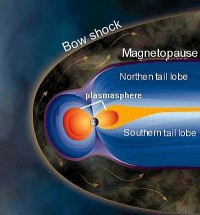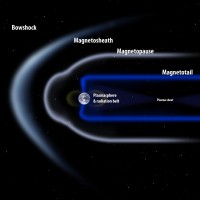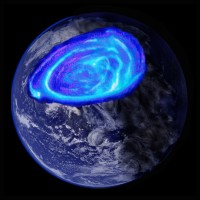Measurements of Earth's magnetic field 3.5 billion years ago reveal a history of battles between the Sun and Earth over our atmosphere

Scientists from the University of Rochester discovered that the strength of the Earth's magnetic field 3.5 billion years ago was about half of what it is today. This weakness, combined with a strong solar wind of energetic particles from the young Sun, likely drove the water from Earth's early atmosphere.
The findings, presented in the journal Science, suggest that the magnetopause - the furthest limit at which the Earth's magnetic field successfully repelled the solar wind - was only half as far from Earth as it is today.
According to the study's author, geophysicist John Tardono of the University of Rochester, with a weak magnetosphere and a young, rapidly rotating sun, Earth received large amounts of protons. On an average day, an amount of protons would be received equivalent to the amount we receive today during a severe solar storm.
When the magnetosphere is weak, the particles flowing from the Sun have a greater chance of reaching the Earth. Therefore, it is very likely to assume that the solar wind removed volatile molecules from the air, such as hydrogen, at a faster rate than the rate of loss of molecules today. According to the researchers, a loss of hydrogen also implies a loss of water, meaning that there may be much less water on Earth today than there was when the planet was formed.
How do you know what was here 3.5 billion years ago?
To find the strength of the ancient magnetic field, Tardono and his South African colleagues from the University of KwaZulu-Natal visited sites in Africa that were known to contain rocks that were abundant 3 billion years ago. Not every rock of this age is suitable for research. In certain basic rocks, such as the igneous rock dacite, there are small millimeter-sized quartz crystals that contain a tiny nanometer-sized magnetic inclusion. The magnetization of these inclusions serves as minute compasses, they maintain the direction and strength of the Earth's magnetic field as the rock cools and transforms from molten magma to solid rock.
Beyond the difficulty of finding suitable rocks that are 3.5 years old, these rocks also bear witness to billions of years of geological activity, processes that can heat them and possibly even change their initial magnetic peak. The solar wind and interaction with the atmosphere can also cause the rock's magnetic field to change, so to prevent their influence he had to choose rocks that have not been affected by the solar wind for 3.5 billion years, that is, choose rocks with a magnetic peak created in the Earth's core and not by the solar wind. To reduce the influence of these factors, Tordo took quartz grains of rocks that formed in the Earth's core 3.5 years ago and have not been affected by the Sun since then.
Once he isolates the ideal crystals, he uses devices that are commonly used by the computer chip industry because of their great sensitivity to small magnetic fields. Using these instruments, University of Rochester students with the permission of John Tredono confirmed that 3.5 billion year old silicate crystals recorded a magnetic field much stronger than being induced by the interaction with the solar wind, indicating that they formed in the Earth's core.
The effect of the solar wind on the magnetic field

The finding was only half of the full picture, now when the data of the ancient magnetic field of the Earth was measured, it was necessary to understand the effect of the solar wind on the magnetic field and the atmosphere. Note that the solar wind can completely remove a planet's atmosphere and hit its surface with deadly radiation. Mars is an example of a planet that lost its magnetosphere early in its history after a blast from the solar wind eroded its atmosphere.
To find out what kind of solar wind reached Earth, the team enlisted the help of Erik Mamjek, a professor of physics and astronomy at the University of Rochester. According to Mamjack, there is a high correlation between the age of a sun-like star and the amount of material it releases through the solar wind. Judging by the rotation and solar activity I expect from a billion-year-old star, the amount of material contained in the solar wind was 100 times higher than the average rate measured in the modern era. According to Prof. Mamjek, while the life cycle of stars like our sun is known, we do not know the mass that is lost through the solar wind. Measuring X-rays from the star, regardless of apparent brightness, can give a good estimate of the amount of material that the star emits through the solar wind. Although the diameter of the sun at the time in question was 23% of its diameter today, the amount of radiation emitted was much more massive and the solar wind was much stronger. The combination of a strong solar wind and a weak magnetosphere creates a balance point between the two forces much closer to the Earth than it is today. It was probably less than five Earth radii, which is less than half the distance of 10.7 radii today.
effect on the atmosphere

Tardono adds that a small magnetopause allows the solar wind to reach closer to the surface and penetrate deeper into the atmosphere, evidence that points to a higher removal of water vapor from the ancient Earth and a larger polar aurora.
The Earth's magnetic field curves vertically at the poles and the solar wind moves toward the Earth's surface. When the solar wind blows through the atmosphere, photons are released that look like dancing lights in the night sky. With a weak magnetic field and a strong solar wind, the magnetic pole was three times larger than it is today, so that on a normal night 3.5 billion years ago the aurora would have been visible even in New York.
The study included colleagues from the University of KwaZulu-Natal (South Africa), NASA, the Chinese Academy of Geological Sciences (Beijing), and the University of Oslo (Norway) and was supported by the John Simon Guggenheim Foundation of the National Science Foundation.

7 תגובות
This sentence "We note that the solar wind can completely remove a planet's atmosphere" is not true for Earth.
Take Venus for example. – Venus has no magnetic field!
Compared to Earth, it is exposed to a stronger solar wind with lower gravity, yet its atmosphere is larger than Earth's - pressure on the surface is around 80-100 atmospheres.
Mars lost most of its atmosphere because its gravity was low and the water froze below the surface - it didn't lose it to space.
(It is true that Venus lost its water to space, but probably more because of the greenhouse effect raging in it than the solar wind)
The intention of removing water vapor from the atmosphere and evaporation of hydrogen from the atmosphere is that the water vapor and hydrogen actually "escaped" into space? Or the hydrogen has disintegrated (very unlikely).
I'm missing one thing in this article:
How exactly did the magnetic field increase over time so that today it is 2 times higher
Stronger than 3.5 billion years ago? I would appreciate an informed answer.
The Sun is aging and warming Three and a half billion years ago the Sun was thirty percent less hot
Protons = hydrogen
It is possible that a significant percentage of the water on Earth was formed from hydrogen that arrived as protons from the solar wind
As far as I know, there were many, many other factors that affected the temperature, before 3.5 is a lifetime ago, so there is no oxygen, and there are many other factors that could affect one way or the other (heating or cooling) so it doesn't really mean if it was colder Or hotter than today..
Therefore, a higher removal of water vapor from the atmosphere 3.5 billion years ago caused a serious disruption of the most important greenhouse gas (water vapor) and thus the average temperature on the earth's surface should have been extremely low compared to today. Did the increase in the earth's magnetic field over the years and a weaker sun indirectly create good conditions for the existence of life?